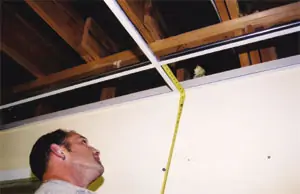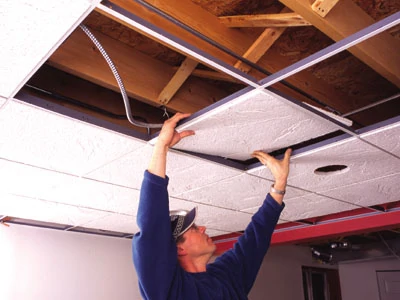Acoustic ceilings earn their name from the sound-absorbent tiles that “soften” the surface of the ceiling to deaden reverberating noise. This also helps block sound transmission to other rooms. But noise reduction isn’t the only advantage acoustic tile offers as a ceiling material. When suspended from the ceiling in a grid, the tiles are handy for concealing wires and pipes, and also allow easy access to those utilities when it’s time to repair or remodel.
The perception of acoustic ceilings among homeowners has changed over the years. No longer are they limited to those large, unremarkable tiles often found in schools or department stores. Today, various styles and colors afford a wide variety of choices that range from traditional perforated textures to those that mimic slate, stucco, swirls or even corduroy. Interlocking tiles can create an elaborate, decorative pattern. And different edge treatments are also available to dress up suspended tiles.
With more styles and options on the market than ever before, now might be the time to renovate your acoustic ceiling, or perhaps install a new one to ease the noise level in your family room. The EHT staff caught up with remodeler Jeff Davis of Birmingham, Alabama, who walked us through a renovation of a standard suspended-grid acoustic ceiling.
Choosing Tile
In addition to your preferred style, texture and color, Davis recommends you consider the material properties of acoustic tile when selecting a product. Read the packaging carefully and be sure to ask the dealer about the maintenance requirements. Some tiles are washable; some tiles are not. And most tiles are difficult, if not impossible, to paint correctly. This is because the tiny holes on the surface of the tile must not be clogged with paint. Otherwise the tile loses its acoustical properties.
Acoustic tile has a wide range of noise-reduction capabilities. The sound-deadening properties of tile depend on its surface characteristics, as well as its weight and density. Not all tiles perform as well as others. These acoustical properties are measured with two ratings: the Noise Reduction Coefficient (NRC) and the Ceiling Attenuation Class (CAC). The NRC measures how much noise is absorbed when sound waves hit the surface of a ceiling tile. Tiles are available that offer NRC ratings up to 80 percent. The CAC measures how well the acoustical tile blocks the transmission of sound through the tile. The highest quality tiles offer a CAC rating in the 40 to 44 range. Check the packaging or product brochures to determine how the different products measure up.
Tiles specified for suspended-grid systems are the most widely used product. However, 12-inch interlocking tiles are available that offer a dramatic, almost seamless appearance for the ceiling. Interlocking tiles can be nailed or glued to the ceiling. But keep in mind, while interlocking systems can really add to the décor, once the tiles are in place it will be tough to restore the old ceiling surface. Future change-outs will also be tough, as opposed to using a suspended grid.
With a suspended grid, when it’s time to repair just remove the old tiles and install the new ceiling. Davis was facing a similar situation when we showed up to the jobsite on the outskirts of Birmingham. The house in question had just been purchased by a real estate company, and Davis was charged with sprucing up some of the cosmetic appeal. The tiles of the laundry and utility rooms of the house were warped and stained from water leaks.
Tools and Materials: Utility knife, hammer, chalk line, water or laser level, tape measure, metal snips, pliers, support grid pieces, hanger wire, screw hooks, tiles
Repair and Replace
“You can always tear down the old grid and start from scratch with an entire new grid system,” says Davis, “but a lot of times that’s not really necessary. If your grid is in good shape, square and properly supported, you can probably get by with just replacing the tiles.”

Davis begins by removing the old tile and insulation. The previous tenant had gone overboard with the insulation, stuffing R-30 above the tiles presumably to prevent heat generated by the laundry machines from affecting the rest of the house. Not only was this insulation unnecessarily heavy, but it was not properly supported above the tiles with furring strips. The old tiles and insulation were introduced to the dumpster.
Next step was to inspect the grid for damage. “Some of the runners in this grid are bent, probably because the house has settled and pushed against them,” says Davis. “We’ll have to replace some of the grid components. When it’s complete, we’ll paint it with an epoxy-based paint to make sure it all matches.”



This required a trip to the supply store to purchase replacement cross-tees. If you’re replacing components of a grid system, then make sure the new products match the grid that is already in place. Metal grid systems connect with snap-locking clips, and these clips vary among manufacturers.
New Ceilings
You may not have the luxury of working with a pre-existing grid. If this is the case, you’ll need to exercise extreme care when laying out a new grid. Using 1/4-inch graph paper, diagram the room to scale. This will help you to visualize the grid layout. Be sure to keep the border tiles even, uniform and as wide as possible. If the room is out of square, snap a chalk line down the center and split the difference. This leaves a similar sized border tile on each side of the room which helps disguise the problem.
The first step of a new ceiling installation is to level and fasten the L-shaped molding to the wall. Using a water or laser level makes hanging the wall angle easier, quicker and more accurate than using a carpenter’s level. Nail the molding to the wall at no more than 2-foot intervals. Pay attention to the manufacturer’s minimum height restrictions. Do not try to gain a little extra height in the room. If there is not enough clearance above the bottom of the grid runners, it will be difficult to install the tiles.
If installing molding over an uneven wall surface, install a wood fascia board along the uneven wall. Attach the top of the fascia to the joist and keep the bottom even with the bottom of the wall molding. Use wood screws to secure the molding to the fascia. At outside corners, simply place one angle end over the other. At inside corners, mitered molding looks best.
Patience and attention are key to installing the grid work. The trick is to install the main support runners along the centerline, as well as to ensure the cross-tee slots are in the right location. You can’t just throw up the main runner anywhere. The grid will come with instructions. Read and follow them closely.
To square the grid, stretch a string from one end of the room to the other, where the first main runner will hang. Stretch a second string from the second side of the room to the other, where the first row of cross tees will be placed. The cross-tee notches must line up across each of the main runners. A laser tool or a plumb bob and a 3-4-5 triangle will help you square the main runners and guide the grid installation.
Complete the grid by snapping the end tabs of the cross tees into the slots on the main runner. Davis suggests using metal snips to cut any odd-sized cross members to fit the grid, installing the cut end against the wall molding.
In addition to the snap-together connections, the grid also must be supported by wire connected to the framing members above. For residential applications, use 16-guage wires or heavier to support the main runners, attaching them with eyehole screw hooks. Davis recommends installing wire every 4 feet along the main runners. He also suggests wiring any lighting fixtures independently of the ceiling grid.

“Some building codes require that the ceiling lights be wired separately, especially with fire-rated ceilings,” says Davis. “Fire-rated grids have a special joint in the main runner. If there’s a fire in the home, then when the heat reaches a certain degree the special joint in the runner will fail. It causes the grid to collapse and the tiles to fall to the floor. If the lights are wired to the ceiling, they won’t fall with the grid.”
Hanging the Tile
With the grid in place, it’s finally time to lay the tile. Most manufacturers recommend you remove the acoustic tiles or panels from their package and allow them to adjust to the room conditions overnight. They should be installed at normal room temperature and humidity.
Begin the tile installation with the border pieces. Measure the ceiling grid opening. Be sure to measure the interior dimensions of the grid area. Then deduct 1/8-inch from the result, which will allow the tile to easily slip into the grid area. Lay the tile on a clean, smooth surface and mark the measurements on the back of the tile. It may help to use a straight edge to guide the cut. Make a couple of passes with a razor-bladed utility knife to achieve a clean cut. Then simply place the tile into your grid system.



As you install the final tile into the grid system, you will have created a new sound-absorbent ceiling, giving the room a fresh new look and providing the opportunity for easy remodeling in the future.






